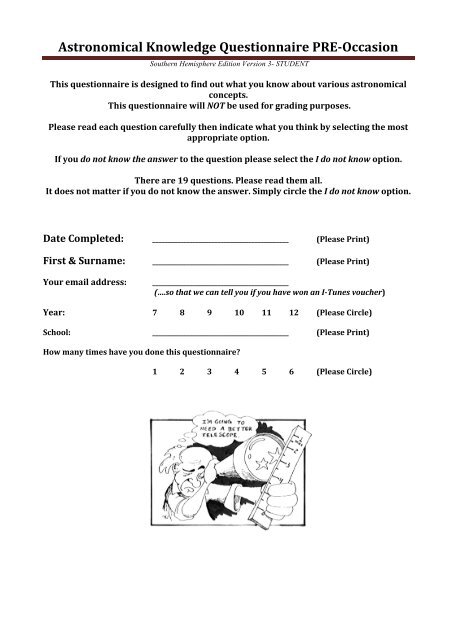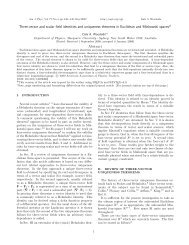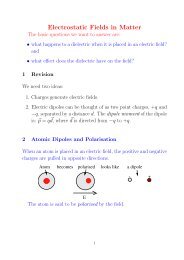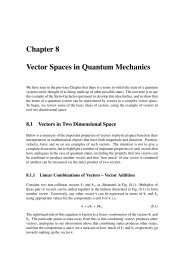Astronomical Knowledge Questionnaire PRE-Occasion
Astronomical Knowledge Questionnaire PRE-Occasion
Astronomical Knowledge Questionnaire PRE-Occasion
Create successful ePaper yourself
Turn your PDF publications into a flip-book with our unique Google optimized e-Paper software.
<strong>Astronomical</strong> <strong>Knowledge</strong> <strong>Questionnaire</strong> <strong>PRE</strong>-<strong>Occasion</strong>Southern Hemisphere Edition Version 3- STUDENTThis questionnaire is designed to find out what you know about various astronomicalconcepts.This questionnaire will NOT be used for grading purposes.Please read each question carefully then indicate what you think by selecting the mostappropriate option.If you do not know the answer to the question please select the I do not know option.There are 19 questions. Please read them all.It does not matter if you do not know the answer. Simply circle the I do not know option.Date Completed: ____________________________________________ (Please Print)First & Surname: ____________________________________________ (Please Print)Your email address:____________________________________________(….so that we can tell you if you have won an I-Tunes voucher)Year: 7 8 9 10 11 12 (Please Circle)School: ____________________________________________ (Please Print)How many times have you done this questionnaire?1 2 3 4 5 6 (Please Circle)
<strong>Astronomical</strong> <strong>Knowledge</strong> <strong>Questionnaire</strong> <strong>PRE</strong>-<strong>Occasion</strong>For each question, check the box of the option you think best.Which sentence best describes why day-time and night-time happen? The Earth’s revolution about the Sun causes night and day. The Earth orbits the Sun by day and the Moon by night. The rotation of the Earth causes day and night. The Earth rotates at the centre while the Sun moves around the Earth. The Moon orbits the Earth daily and blocks sunlight at night. I do not know the answer to this question.Janine looked for the Moon one week. Here is what she saw:Which sentence best describes why Janine saw the Moon these different shapes.The different phases that we see are caused by: The relative positions of the Sun, Earth and the orbiting Moon. The shadow of the Earth falling on different parts of the Moon. Clouds on the Earth covering different amounts of the Moon. Sunlight reflecting from the Earth back to the orbiting Moon. I do not know the answer to this question.Page 2
<strong>Astronomical</strong> <strong>Knowledge</strong> <strong>Questionnaire</strong> <strong>PRE</strong>-<strong>Occasion</strong>Which sentence best describes why summer and winter happen. The Earth’s tilted axis makes one hemisphere of the Earth closer to the Sun so that itis summer while the other half is further away from the Sun making it winter. During summer the hot side of the Sun faces Earth making it warmer while in winterthe cool side of the Sun faces Earth making it cooler. During winter clouds block the light coming from the Sun weakening it while insummer there are few clouds which means the light coming from the Sun is stronger. The Earth’s tilted axis means that one hemisphere has more direct sunlight andlonger days making it summer while the other hemisphere experiences winter. The Sun moves to make one side of the Earth hot for six months making summerwhile the other side of the Earth is cool and experiences winter. I do not know the answer to this question.If a red star and a blue star have the same size (diameter) and are at the samedistance from Earth, which one will appear brighter? The red star. The blue star. Both stars will look the same. There is not enough information given to answer this question. I do not know the answer to this question.Page 3
<strong>Astronomical</strong> <strong>Knowledge</strong> <strong>Questionnaire</strong> <strong>PRE</strong>-<strong>Occasion</strong>Use the drawing below to answer the next question.If you could see stars during the day, the drawing above shows what the skywould look like at noon on a given day. The Sun is at the highest point that it willreach on this day and is near the stars of the constellation Gemini. What is thename of the constellation that will be closest to the Sun at sunset on this day? Leo Taurus Gemini Pisces Cancer I do not know the answer to this question.The Big Bang is best described as: The event that formed all matter and space from an infinitely small dot of energy. The event that formed all matter and scattered it into space. The event that scattered all matter and energy throughout space. The event that organised the current arrangement of planetary systems. The event that formed all matter and space at the beginning of time. I do not know the answer to this question.Page 4
<strong>Astronomical</strong> <strong>Knowledge</strong> <strong>Questionnaire</strong> <strong>PRE</strong>-<strong>Occasion</strong>Which of the following ranks locations,from closest to Earth to farthest from Earth? the Sun, the Moon, Pluto, the Southern Cross, the edge of our galaxy the Moon, the Sun, Pluto, the Southern Cross, the edge of our galaxy the Sun, the Southern Cross, the Moon, the edge of our galaxy, Pluto the Moon, the Southern Cross, the Sun, Pluto, the edge of our galaxy the Southern Cross, the Moon, the Sun, the edge of our galaxy, Pluto I do not know the answer to this question.Consider the six different astronomical objects (A-F) shown below.A. The Solar SystemB. The SunC. JupiterD. Andromeda GalaxyE. Galaxy ClusterF. NebulaWhich of the following is the best ranking (from smallest to largest) for the size ofthese objects? C
<strong>Astronomical</strong> <strong>Knowledge</strong> <strong>Questionnaire</strong> <strong>PRE</strong>-<strong>Occasion</strong>Star Y has twice the mass of star X. How will star X use up its fuel compared to star Y? Star X will use up its fuel more than two times slower than star Y. Star X will use up its fuel two times slower than star Y. Star X will use up its fuel at the same rate as star Y. Star X will use up its fuel two times faster than star Y. Star X will use up its fuel more than two times faster than star Y. I do not know the answer to this question.Current evidence about how the universe is changing tells us that … We are near the centre of the universe. Galaxies are expanding into empty space. Groups of galaxies appear to move away from each other. Nearby galaxies are younger than distant galaxies. I do not know the answer to this question.Stars begin life as a cloud of gas and dust. a piece that comes from a star or planet. a white dwarf. matter in Earth’s atmosphere. a black hole. I do not know the answer to this question.When the Sun reaches the end of its life, what will happen to it? It will turn into a black hole. It will have lost its outer layers, leaving its core behind. It will explode, destroying Earth. It will not die due to its mass. I do not know the answer to this question.How did the planets orbiting our Sun form? The planets and the Sun formed at the time of the Big Bang. The planets were captured by the Sun’s gravity. The planets formed from the same materials as the Sun. The planets formed from the fusion of hydrogen in their cores. I do not know the answer to this question.Page 6
<strong>Astronomical</strong> <strong>Knowledge</strong> <strong>Questionnaire</strong> <strong>PRE</strong>-<strong>Occasion</strong>How would you rank the surface temperatures of red, white, and blue stars fromHottest - Coldest? white - blue - red white - red - blue red - blue - white red - white - blue blue - white - red blue - red - white I do not know the answer to this question.Energy is released from atoms in the form of light when electrons are emitted by the atom. move from low energy levels to high energy levels. move from high energy levels to low energy levels. move in their orbit around the nucleus. I do not know the answer to this question.Which of the following would be true about comparing visible light and radiowaves? The radio waves would have a lower energy and would travel slower thanvisible light. The visible light would have a shorter wavelength and a lower energy thanradio waves. The radio waves would have a longer wavelength and travel the same speedas visible light. The visible light would have a higher energy and would travel faster thanradio waves. The radio waves would have a shorter wavelength and higher energy thanvisible light. I do not know the answer to this question.The atoms in the plastic of your chair were formed in our Sun. by a star existing prior to the formation of our Sun. at the instant of the Big Bang. approximately 100 million years ago. in a distant galaxy in a different part of the early universe. I do not know the answer to this question.Page 7
<strong>Astronomical</strong> <strong>Knowledge</strong> <strong>Questionnaire</strong> <strong>PRE</strong>-<strong>Occasion</strong>The graphs below illustrate the energy output versus wavelength for threeunknown objects A, B, and C. Which of the objects has the highest temperature?Energy Output per secondAEnergy Output per secondBEnergy Output per secondCV I B G Y O RWavelengthV I B G Y O R Wavelength(V=violet, I=indigo, B=Blue, G=Green, Y=yellow, O=orange, R=red) A B C All three objects have the same temperature. The answer cannot be determined from this information. I do not know the answer to this question.V I B G Y O RWavelengthHow does the Sun produce the energy that heats our planet? The gases inside the Sun are burning and producing large amounts of energy. Gas inside the Sun heats up when compressed, giving off large amounts of energy. Heat trapped by magnetic fields in the Sun is released as energy. The core of the Sun has radioactive atoms that give off energy as they decay. Hydrogen is combined into helium, giving off large amounts of energy. I do not know the answer to this question.Thank you very much for taking the time to complete this!Page 8
















